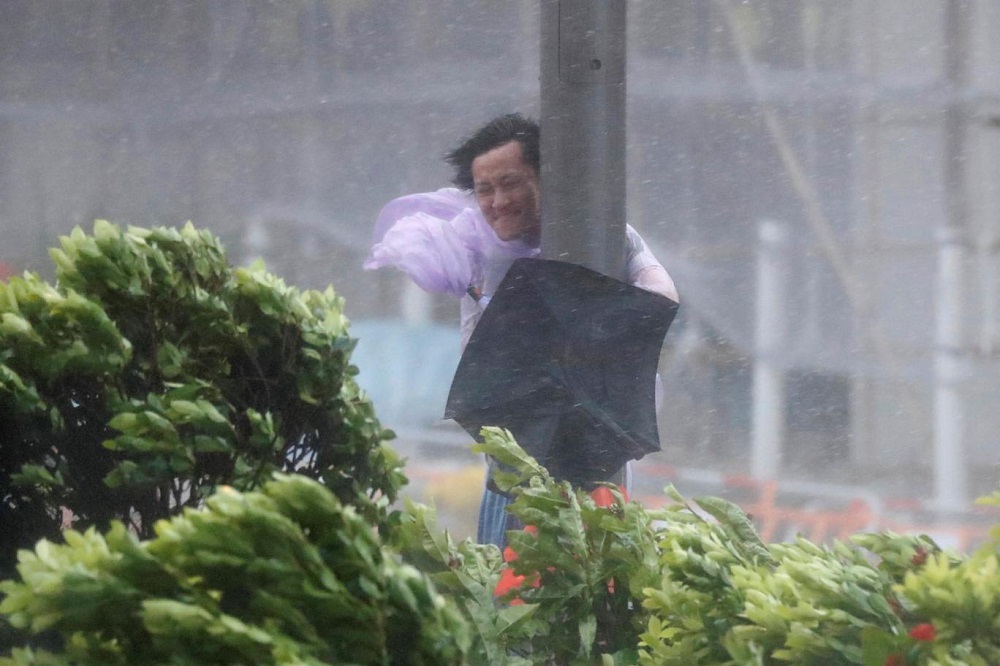Three people were killed on Wednesday and 34 injured as Typhoon Hato, a maximum category 10 stormed, battered Hong Kong with wind and rain that forced a majority of businesses to close.
Three men aged 30 to 65 died, the Macau government said, while two people were missing. One of the men died after being injured by a wall that blew down, another fell from a fourth floor terrace and the last was a Chinese tourist hit by a truck.
Financial markets were suspended and schools were closed as Hato bore down, the first category 10 storm to hit the city since 2012.
Many skyscrapers in the usually teeming streets of Hong Kong were empty and dark as office workers stayed at home.
Hato, that means “sky pigeon” in Japanese, churned up Hong Kong’s Victoria Harbor and triggered large swells and big waves on some of the city’s most popular beaches, with serious flooding in low-lying areas.
“I’ve never seen one like this,” Garrett Quigley, a longtime resident of Lantau island to the west of the city, said of the storm.
“Cars are half submerged and roads are impassable with flooding and huge trees down. It’s crazy.”
In residential districts such as Heng Fa Chuen on densely populated Hong Kong island, waves smashed against the sides of oceanfront buildings and surged over a promenade, sweeping away walls and benches and swamping vehicles parked nearby.
Construction cranes swayed at the tops of skyscrapers, windows imploded and nearly 200 trees were uprooted, while some people used canoes to venture out into flooded streets.
Authorities downgraded the storm to a category three by late-afternoon with government services, the courts, financial markets and companies set to resume normal business on Thursday.
The storm also caused a power blackout across most of the gambling hub of Macau for about two hours, residents said, with disruption to mobile phone and internet networks. There was severe flooding on the streets, with some cars almost completely submerged, and the water supply was affected in some districts. The three men who died included a 45-year-old Chinese tourist who was hit by a heavy truck, according to a government statement.
Brian Chan, 31, said authorities had failed to give enough notice of the impending storm and were not properly prepared, describing the territory as “totally lost” in the typhoon.
The storm also made landfall in China’s Guangdong province, in Zhuhai city adjacent to Macau, Chinese state news agency Xinhua reported.
Numerous flights and trains were canceled in Guangdong province, with Shenzhen’s International Airport particularly badly hit.
Thousands of residents along the Chinese coast were evacuated and fishing vessels were called back to port.
Maximum winds near Hato’s center were recorded at a destructive 155 kph (95 mph) as it continued to move west across Guangdong in the general direction of Hainan island.
A senior scientific officer for the Hong Kong observatory warned that sea levels could rise several meters in some places, with the government issuing flood alerts and opening 27 shelters across the city.
Trading in Hong Kong’s financial markets was halted for the day, the stock exchange said. Typhoon Nida in August last year was the last storm to close the exchange for the whole day.
The city’s flagship carrier, Cathay Pacific, and Hong Kong Airlines said the majority of their flights to and from Hong Kong between 2200 GMT Tuesday and 0900 GMT Wednesday would be canceled.
Other transport services, including ferries to Macau and outlying islands in Hong Kong, were suspended.
Hong Kong is regularly besieged by typhoons between July and October, but direct hits are rare.
The city saw its strongest storm in 1962 when the eye of typhoon Wanda passed over and gusts of 284 kilometers per hour were recorded.
It killed 130 people and destroyed thousands of residential huts, leaving 72,000 people homeless.
